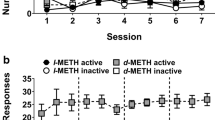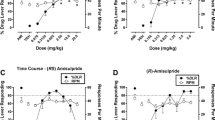Abstract
Eight male community volunteers, who reported current psychomotor stimulant use, were trained to discriminate between the presence and absence of orally administeredd-amphetamine 30 mg. During daily experimental sessions, in which a single drug dose or placebo was tested, physiological and subjective measures were assessed and subjects indicated their discrimination by responding on an operant color-tracking procedure. During four test of acquisition sessions, discriminative responding indicated that all subjects learned the discrimination, andd-amphetamine produced physiological and subjective effects typical of psychomotor stimulants. Generalization testing then followed in which dose-response curves were determined for the following drugs:d-amphetamine (3.75, 7.5, 15 and 30 mg), diazepam (5, 10, 20 and 40 mg), and methylphenidate (7.5, 15, 30 and 60 mg).d-Amphetamine and methylphenidate produced dose-related increases ind-amphetamine-appropriate responding, whereas no dose of diazepam substituted ford-amphetamine in any subject.d-Amphetamine and methylphenidate produced a similar pattern of subjective changes, including increased ratings of euphoria and drug liking and decreased sedation. In contrast, diazepam increased subjective scales of sedation and dysphoria. These results are consistent with similar studies testing animals and humans and demonstrate the utility of human drug discrimination research as an integral component of drug abuse liability testing.
Similar content being viewed by others
References
Bickel WK, Etzel BC (1985) The quantal nature of controlling stimulus-response relations as measured in tests of stimulus generalization. J Exp Anal Behav 44:245–270
Bickel WK, Bigelow GE, Preston KL, Liebson IA (1989) Opioid drug discrimination in humans: Stability, specificity and relation to self-reported drug effect. J Pharmacol Exp Ther 251:1053–1063
Blouin AG (1987) Computerized Diagnostic Interview Schedule-Version 3.2. Ottowa Civic Hospital, Ottowa
Chait LD, Johanson CE (1988) Discriminative stimulus effects of caffeine and benzphetamine in amphetamine-trained volunteers. Psychopharmacology 96:302–308
Chait LD, Uhlenhuth EH, Johanson CE (1984) An experimental paradigm for studying the discriminative stimulus properties of drugs in humans. Psychopharmacology 82:272–274
Chait LD, Uhlenhuth EH, Johanson CE (1985) The discriminative stimulus and subjective effects ofd-amphetamine in humans. Psychopharmacology 86:307–312
Chait LD, Uhlenhuth EH, Johanson CE (1986a) The discriminative stimulus and subjective effects ofd-amphetamine, phenmetrazine and fenfluramine in humans. Psychopharmacology 89:301–306
Chait LD, Uhlenhuth EH, Johanson CE (1986b) The discriminative stimulus and subjective effects of phenylpropanolamine, mazindol andd-amphetamine in humans. Pharmacol Biochem Behav 24:1665–1672
Colpaert FC (1986) Drug discrimination: behavioral, pharmacological, and molecular mechanisms of discriminative drug effects. In: Goldberg SR, Stolerman IP (eds) Behavioral analysis of drug dependence. Academic Press, Orlando, pp 161–193
Colpaert FC, Slangen JL (eds) (1982) Drug discrimination: applications in CNS pharmacology. Elsevier, Amsterdam
de la Garza R, Johanson CE (1987) Discriminative stimulus properties of intragastrically administeredd-amphetamine and pentobarbital in rhesus monkeys. J Pharmacol Exp Ther 243:955–962
Derogatis LR (1975) The Symptom Checklist-90-R. Clinical Psychometrics Research, Baltimore
Evans SM, Johanson CE (1987) Amphetamine-like effects of anorectics and related compounds in pigeons. J Pharmacol Exp Ther 243:817–825
Fraser HF, van Horn GD, Martin WR, Wolbach AB, Isbell H (1961) Methods for evaluating addiction liability. (A) “Attitude” of opiate addicts toward opiate-like drugs, (B) A short-term “direct” addiction test. J Pharmacol Exp Ther 133:371–387
Glennon RA, Young R (1984) Further investigation of the discriminative stimulus properties of MDA. Pharmacol Biochem Behav 20:501–505
Griffiths RR, Bigelow GE, Liebson I (1983) Differential effects of diazepam and pentobarbital on mood and behavior. Arch Gen Psychiatry 40:865–873
Griffiths RR, McLeod DR, Bigelow GE, Liebson IA, Roache JD (1984) Relative abuse liability of diazepam and oxazepam: behavioral and subjective dose effects. Psychopharmacology 84:147–154
Griffiths RR, Evans SM, Heishman SJ, Preston KL, Sannerud CA, Wolf B, Woodson PP (1990) Low-dose caffeine discrimination in humans. J Pharmacol Exp Ther 252:970–978
Heishman SJ, Stitzer ML (1989) Effects ofd-amphetamine, secobarbital, and marijuana on choice behavior: Social versus nonsocial options. Psychopharmacology 99:156–162
Jarbe TUC (1982) Discriminative stimulus properties ofd-amphetamine in pigeons. Pharmacol Biochem Behav 17:671–675
Lal H (ed) (1977) Discriminative stimulus properties of drugs. Plenum Press, New York
Martin WR, Sloan JW, Sapira JD, Jasinski DR (1971) Physiologic, subjective, and behavioral effects of amphetamine, methamphetamine, ephedrine, phenmetrazine, and methylphenidate in man. Clin Pharmacol Ther 12:245–258
Mathias DA, Emmett-Oglesby MW, Harris CM, Lal H (1987) Quantal nature of generalization and acquisition responding by rats in a drug discrimination task. Psychol Rec 37:161–165
McMillan DE, Cole-Fullenwider DA, Hardwick WC, Wenger GR (1982) Phencyclidine discrimination in the pigeon using color tracking under second-order schedules. J Exp Anal Behav 37:143–147
Preston KL, Bigelow GE, Bickel W, Liebson IA (1987) Three-choice drug discrimination in opioid-dependent humans: hydromorphone, naloxone and saline. J Pharmacol Exp Ther 243:1002–1009
Preston KL, Bigelow GE, Bickel W, Liebson IA (1989) Drug discrimination in human postaddicts: agonist-antagonist opioids. J Pharmacol Exp Ther 250:184–196
Rosen JB, Young AM, Beuthin FC, Louis-Ferdinand RT (1986) Discriminative stimulus properties of amphetamine and other stimulants in lead-exposed and normal rats. Pharmacol Biochem Behav 24:211–215
Schuster CR, Johanson CE (1988) The relationship between the discriminative stimulus properties and subjective effects of drugs. In: Colpaert FC, Balster RL (eds) Transduction mechanisms of drug stimuli. Springer, Berlin Heidelberg New York, pp 161–175
Wenger GR (1987) Discriminative stimulus properties of barbiturates isomers in pigeons using a color-tracking procedure. Fed Proc 46:1130
Author information
Authors and Affiliations
Rights and permissions
About this article
Cite this article
Heishman, S.J., Henningfield, J.E. Discriminative stimulus effects ofd-amphetamine, methylphenidate, and diazepam in humans. Psychopharmacology 103, 436–442 (1991). https://doi.org/10.1007/BF02244241
Received:
Revised:
Issue Date:
DOI: https://doi.org/10.1007/BF02244241




